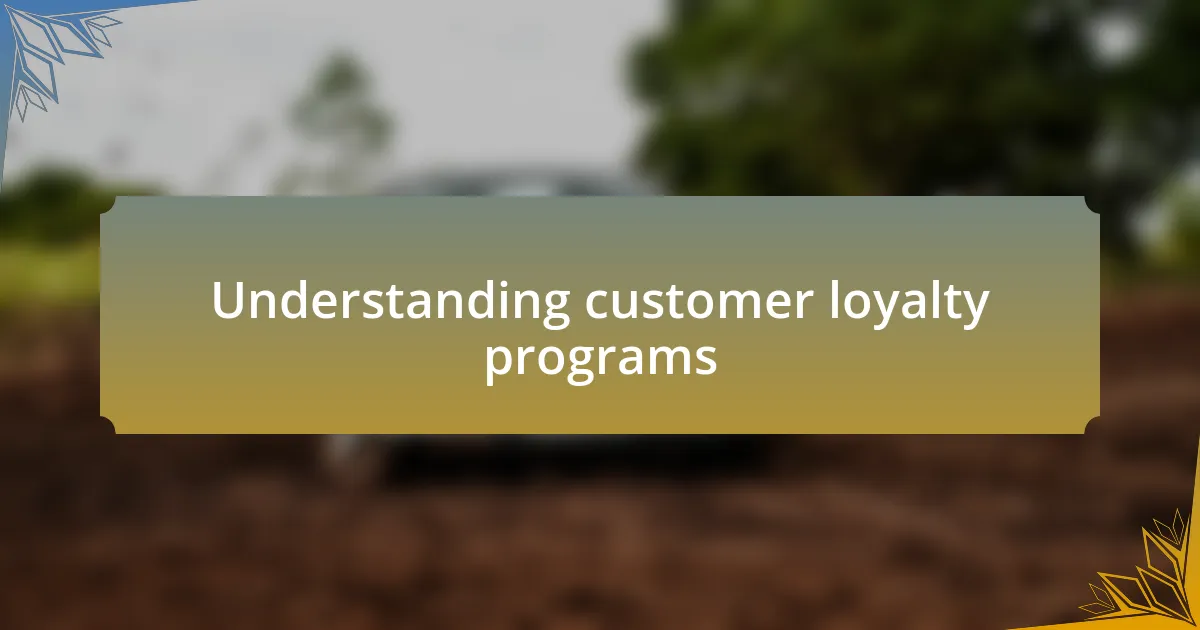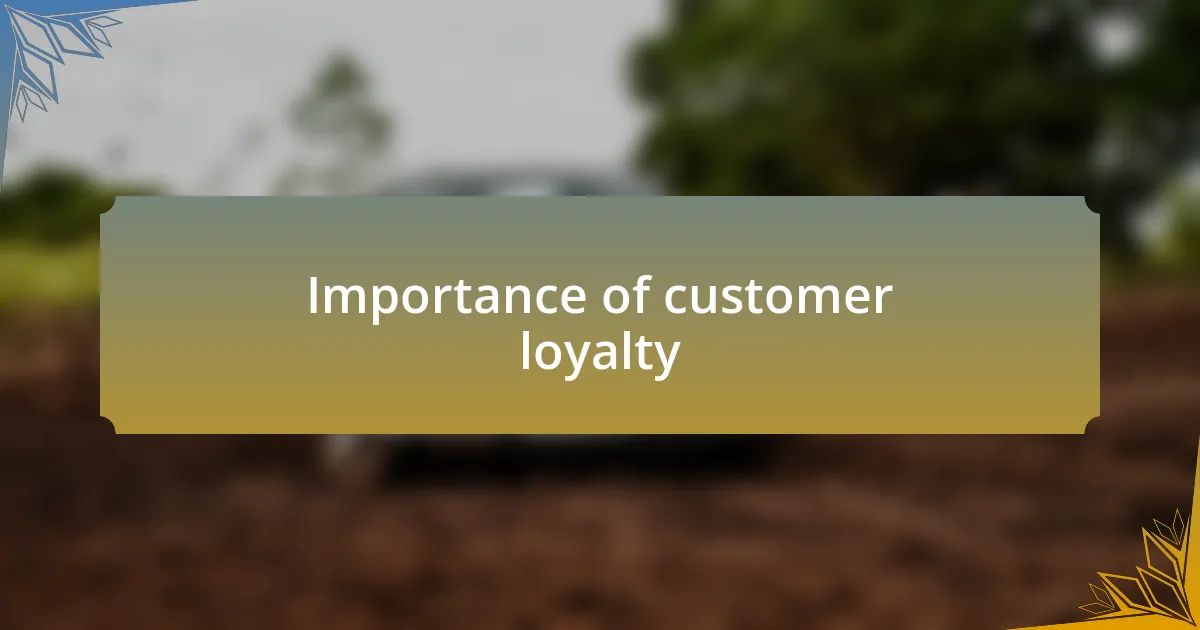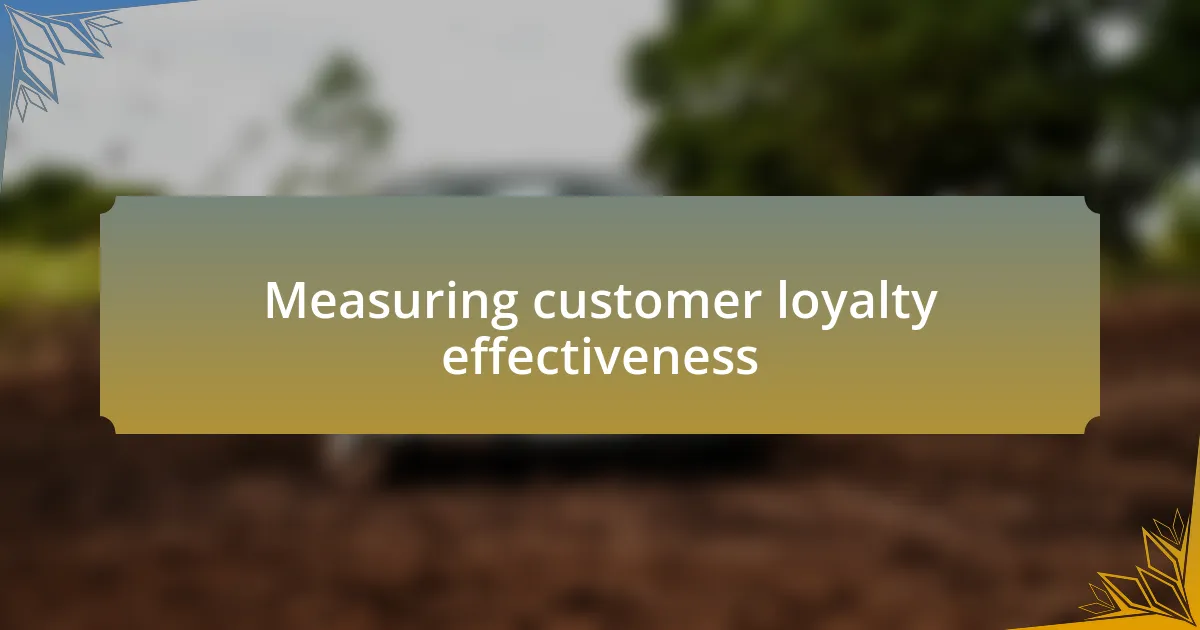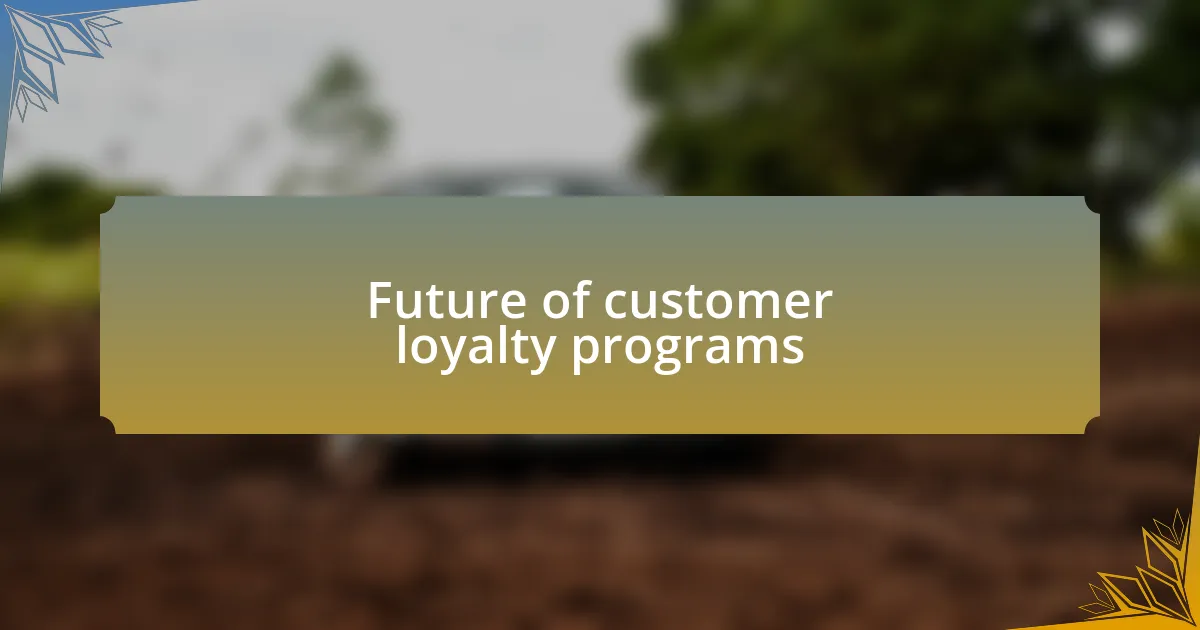Key takeaways:
- Successful customer loyalty programs focus on creating emotional connections rather than just offering discounts.
- Key features like tiered rewards, personalization, and flexible redemption options enhance customer engagement and loyalty.
- Measuring program effectiveness through metrics, customer feedback, and analyzing customer lifetime value is essential for optimization.
- Future trends indicate that technology, sustainability, and community-building will play significant roles in loyalty program evolution.

Understanding customer loyalty programs
Customer loyalty programs are strategic initiatives designed to encourage repeat business, but their effectiveness hinges on how well they resonate with customers’ desires and needs. I’ve often found that when businesses genuinely understand their clientele, the loyalty programs become more than just transactions; they transform into rewarding experiences that foster trust. Have you ever felt a special connection when a brand recognizes your loyalty with personalized offers? That’s the power of a well-executed program.
In my experience, successful loyalty programs focus on creating genuine emotional connections rather than simply offering discounts. For instance, I once joined a program that not only rewarded purchases but also celebrated my milestones with surprise gifts. It made me feel valued beyond just my spending amount. How often do businesses tap into these emotional aspects to elevate customer experience?
It’s interesting to observe how varying structures of loyalty programs can influence participation. Some consumers gravitate towards points-based systems, while others prefer tiered rewards that align with their spending habits. Personally, I’ve interacted with both models and found that clear communication of benefits and progress engages me more. When was the last time you checked your loyalty points, eager to see how close you were to that next reward? This urgency reflects a deeper understanding of customer engagement strategies that truly resonate.

Importance of customer loyalty
Customer loyalty is a cornerstone of sustainable business success. When customers feel valued, they’re more likely to return, which I’ve seen firsthand in my interactions with brands that prioritize loyalty. I remember when a coffee shop I frequented offered me a free drink after my tenth purchase. That small gesture made me feel appreciated and encouraged not just my return but also my advocacy for their brand among friends.
Building loyalty translates to increased customer lifetime value. It’s not just about making a sale; rather, it’s about cultivating relationships that contribute to long-term growth. I once experienced this with a clothing retailer that sent me personalized outfit recommendations based on my past purchases. Their attention to detail made me more inclined to shop there consistently and share my positive experiences on social media. Have you noticed how a little personalization can significantly impact your shopping journey?
Moreover, loyal customers can be the best marketing tool. Their word-of-mouth referrals often carry more weight than traditional advertising. I recall recommending a subscription service to my peers simply because of how satisfied I was with their offerings. This sense of community and trust not only boosts a brand’s reputation but also creates a network of customers who are emotionally invested. Doesn’t that make you think about the real value of cultivating loyalty beyond mere transactions?

Key features of loyalty programs
Key features of loyalty programs can significantly impact customer engagement and retention. One of the most effective features I’ve encountered is tiered rewards. This approach creates a sense of achievement as customers progress through levels, much like earning badges in a game. I once enjoyed reaching a VIP status at a bookstore, where my loyalty unlocked exclusive author signings and early access to new releases, making me feel like a valued member of a community rather than just a shopper.
Another important feature is personalization, which I find increasingly essential. When brands tailor rewards to individual preferences, it feels as if they truly understand their customers. I experienced this firsthand when a beauty brand sent me personalized discounts on products I frequently purchased. This not only made me feel recognized but also reminded me of my favorite items, encouraging me to shop more often. Isn’t it fascinating how understanding what your customers want can lead to stronger connections?
Flexibility in redemption options also stands out as a key feature. I’ve noticed that programs allowing various ways to spend points—whether for discounts, exclusive products, or charitable donations—enable customers to choose what matters most to them. Last year, I decided to donate my rewards points to a local charity through a pet supply store’s program. That experience deepened my loyalty, making me feel my choices aligned with my values. Isn’t it remarkable how empowering customers can transform their relationship with a brand?

Best practices for implementation
When implementing a customer loyalty program, it’s crucial to start with clear goals. I remember when I worked on a project to enhance a local café’s loyalty system; we focused on increasing repeat visits. Aligning our program goals with business objectives not only motivated the team but also ensured we measured success effectively. Have you ever set a clear intention and found it easier to track progress?
Another best practice is to actively seek customer feedback during the rollout. In my experience, engaging customers in the design phase can lead to ideas that truly resonate. For instance, a clothing retailer I worked with held informal focus groups that turned out to be goldmines of insights. By incorporating customer input, they felt more connected to the program, which in turn drove higher engagement.
Training staff is another vital step often overlooked. I’ve seen firsthand how enthusiastic team members can make or break a loyalty program’s success. While at a hotel chain, we conducted role-playing exercises to ensure staff understood how to promote and explain the program benefits. This not only empowered them but also created a seamless experience for guests, reinforcing the feeling that they’re part of something special. How does it feel to be greeted by a staff member who genuinely believes in the value they’re offering?

Measuring customer loyalty effectiveness
Measuring the effectiveness of customer loyalty programs can be daunting, but I’ve discovered practical methods that make a significant difference. For instance, when I managed a loyalty initiative at an e-commerce site, we tracked metrics like repeat purchase rates and customer retention over time. It was rewarding to see how those numbers not only reflected our efforts but also guided us in optimizing the program based on actual user behavior. Have you ever felt the satisfaction of seeing your hard work translate into tangible results?
Another aspect I found crucial is implementing customer satisfaction surveys after program interactions. During one project with a local bookstore, we integrated brief post-purchase surveys asking how the loyalty program influenced their shopping experience. This direct feedback was invaluable; it not only highlighted areas for improvement but also allowed us to celebrate the aspects customers loved. Don’t you think that listening directly to your customers can unlock insights you might otherwise miss?
Lastly, I believe analyzing the lifetime value of loyal customers provides a powerful insight into program effectiveness. For a gourmet food partner I worked with, we discovered that loyal customers not only spent more money but also referred new clientele, creating a ripple effect. This understanding made it clear that investing in loyalty could lead to a flourishing community around our brand. How does it feel to know that cultivating loyalty can directly influence your growth trajectory?

Personal insights on loyalty trends
The landscape of customer loyalty is evolving, and I’ve seen firsthand how personalization plays a pivotal role. When I worked with a travel company, we tailored loyalty rewards based on individual travel histories. The smiles on our customers’ faces when they received personalized offers were priceless. It made me realize that understanding preferences can significantly strengthen emotional connections.
I’ve also observed a growing trend towards experiential rewards in loyalty programs. One time, collaborating with a local café, we shifted from traditional discounts to exclusive events like cooking classes for loyal patrons. The enthusiasm from participants was overwhelming! This shift not only fostered community but also deepened the loyalty bond. Have you ever participated in such an experience where it felt less like a transaction and more like a shared journey?
Lastly, I can’t help but notice the importance of social engagement in loyalty trends. At one point, I was involved in creating a loyalty program that encouraged customers to share their experiences on social media. Seeing our customers proudly displaying their rewards not only boosted visibility but also created a sense of belonging. Don’t you think that fostering a community around your brand can lead to loyalty that goes beyond mere transactions?

Future of customer loyalty programs
As I look ahead, I foresee that the future of customer loyalty programs will increasingly integrate technology, particularly through Artificial Intelligence (AI). During a project where I explored AI tools, I noticed how they could analyze customer data in real-time, allowing brands to adapt their offerings instantaneously. Can you imagine the surprise and delight customers will feel when they receive tailored rewards that seem to know them better than they know themselves?
Additionally, I believe sustainability will play an essential role in shaping these programs. When I worked with a retail client focused on eco-friendly products, we launched a loyalty initiative that offered rewards for sustainable purchases. The heartfelt stories from customers sharing their commitment to the environment were truly inspiring. Isn’t it fascinating how aligning a loyalty program with ethical values can create a deeper connection with the audience?
Moreover, I find that community-building is destined to become a core component of loyalty initiatives. In a collaboration with a local bookstore, we initiated a member-exclusive book club that fostered genuine conversations and connections among readers. The excitement and sense of belonging experienced by members were palpable. Wouldn’t it be wonderful if more brands embraced this idea, transforming loyalty into a shared experience that enriches lives?